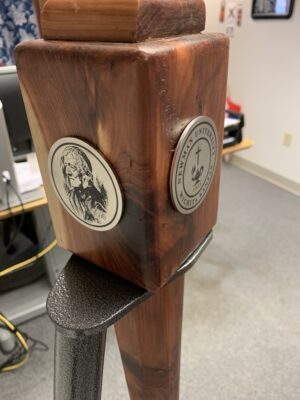With the help of many members of the Newman community, the university has gained a new heirloom: a mace made of red cedar that pays homage to the university’s roots.
A mace is a ceremonial staff often used by universities to lead commencement or convocation processions.
When Lori Gibbon took the position of Registrar in 2018, she noticed that there was no mace at the graduation ceremony and she set out to change that.

“The idea of a ceremonial mace to open graduation ceremonies is not a new one and it was a part of every institution where I have previously worked,” said Gibbon.
“I was interested in having a ceremonial mace crafted that would become an heirloom for the university — to serve as part of our amazing history and dedication to educating students that transform society.”
Gibbon approached Vice President for Academic Affairs Kimberly Long, Ph.D., who immediately suggested reaching out to Newman community member Father Tom Welk — a talented woodworker.
Welk crafted the benches that sit outside of St. John’s Chapel and was excited to help with another project.
His first question was, “What is a mace?”
“First, I thought of pepper spray,” he said. “Then the image of a club came to me. This was more relevant than pepper spray. But why build a fancy club?”
Once he found the definition of a ceremonial mace, he got to work sketching out his plan.
Welk and Senior Graphic Designer Matthew Miller worked together to create a cohesive design for the full piece. Gibbon had given specific requirements for length, the use of medallions and a four-sided head, but left the rest up to their creative minds.
Miller said, “I researched not only the history of the mace but also looked at maces used by other universities. The use of ceremonial maces goes as far back as the late Stone Age, and in educational institutions, the University of St. Andrews in Scotland has ceremonial maces dating to the 15th century. In its current form, the ceremonial mace has come to be a unique representation of the institution it was created for and used by.”
Using his research, Miller knew he had to create something that represented all of the most important elements of Newman University.

“Each side of the mace holds a medallion with a visual representation of the university: the official university seal, the official university logo, the Adorers of the Blood of Christ (ASC) logo and a line etching of the university’s namesake, St. John Henry Newman.
The metal cross on the top of the mace is the same cross used in the Newman University logo.
While Miller took the reins on the medallions and metalwork designs, Welk got to work on the mace itself.
The wood used to create the mace has significant Newman ties.
“The wood came from a massive eastern red cedar tree that had been growing by the grotto on the west side of the administration building,” explained Welk. “The tree blew over during a summer storm several years ago.”
“Sister Charlotte Rohrbach, director of mission effectiveness, surmises that the tree spans the entire history of Newman University in its various stages. The number of tree rings gives evidence of this. Sister Charlotte wanted this tree to continue to be a part of Newman’s history, so she contacted me about building some benches for the doors by the chapel.”

Welk knew the wood from this tree would be the perfect material for a project like the ceremonial mace.
Though Welk is a woodworker, he lacked some of the necessary tools needed to craft the mace. He contacted former Board of Trustees Chair Linda Davison’s husband, Joe, who has a well-equipped woodshop.
Joe and his brother, Leroy Goodnight, offered their tools, time and expertise to help craft such an important part of Newman’s history.
“I wanted to be sure the mace was well-designed and well-crafted so I was not hesitant to enlist the help of other individuals to ensure this would be the case,” said Welk.
The mace wouldn’t be complete without the images that tie it to Newman and its history.
The images were designed by Miller and sent to J.R. Custom Metal Products, who graciously offered to create the metalwork at a low cost. They created four medallions for each face of the cubed head and a metal cross to adorn the top of the mace. They also worked with Welk to manufacture a stand to hold the mace.
Board of Trustees member Patty Koehler generously donated the cost for the metalworks.

Newman University logo adorns the
top of the mace
“The end result is a creation more beautiful than I could have imagined,” said Gibbon. “It is everything and more than I had originally hoped it could be. Father Tom is a master craftsman and knowing that the wood used to create the mace has historical significance to campus makes it all the more special.
“Father Tom worked with J.R. Custom Metal Products to create the stand to hold the mace, and the stand is just as amazing as the mace itself. It will now have a prominent place on the commencement stage and be a lovely part of our graduation ceremonies.”
There are plans to display the mace in the Heritage Room located inside Sacred Heart Hall when it is not in use.

